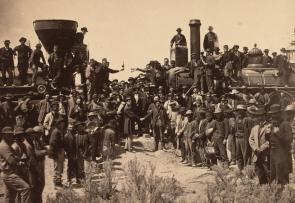Official photograph from the "Golden Spike" Ceremony, 1869
A Spotlight on a Primary Source by Andrew J. Russell
 This iconic photograph records the celebration marking the completion of the first transcontinental railroad lines at Promontory Summit, Utah, on May 10, 1869, when Leland Stanford, co-founder of the Central Pacific Railroad, connected the eastern and western sections of the railroad with a golden spike. This “joining of the rails” was the culmination of work commenced in 1863 when the Central Pacific began laying track eastward from Sacramento, California, and the Union Pacific started laying track westward from Omaha, Nebraska, in July of 1865. To meet its manpower needs, the Central Pacific hired 15,000 laborers, of whom more than 13,000 were Chinese immigrants. These immigrants were paid less than white workers, and, unlike whites, had to provide their own lodging. The crew had the formidable task of laying the track across California’s Sierra Nevada mountain range, blasting fifteen tunnels to cover 1,776 miles with 4,814 feet of new track.
This iconic photograph records the celebration marking the completion of the first transcontinental railroad lines at Promontory Summit, Utah, on May 10, 1869, when Leland Stanford, co-founder of the Central Pacific Railroad, connected the eastern and western sections of the railroad with a golden spike. This “joining of the rails” was the culmination of work commenced in 1863 when the Central Pacific began laying track eastward from Sacramento, California, and the Union Pacific started laying track westward from Omaha, Nebraska, in July of 1865. To meet its manpower needs, the Central Pacific hired 15,000 laborers, of whom more than 13,000 were Chinese immigrants. These immigrants were paid less than white workers, and, unlike whites, had to provide their own lodging. The crew had the formidable task of laying the track across California’s Sierra Nevada mountain range, blasting fifteen tunnels to cover 1,776 miles with 4,814 feet of new track.
A close study of the photograph reveals that the Chinese workers who were present that day have been excluded. This absence encourages students to consider that all photographs reflect choices made by the artist—and to question accepting photographs as complete or comprehensive records of historical events.
